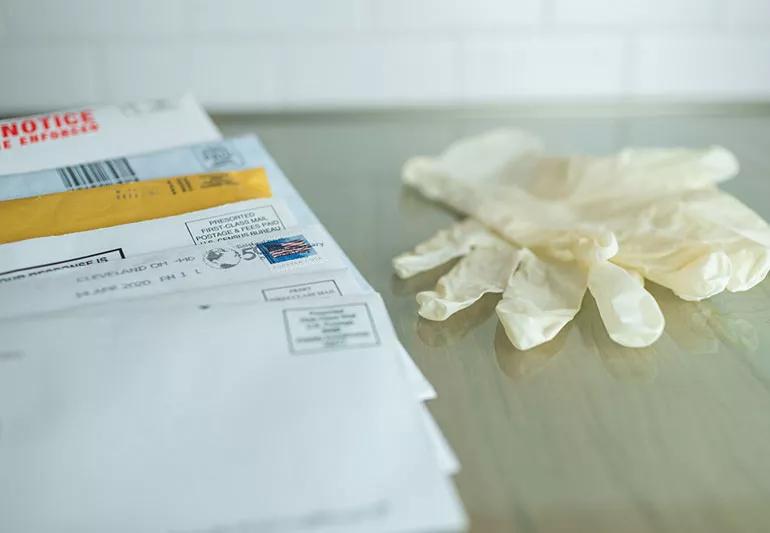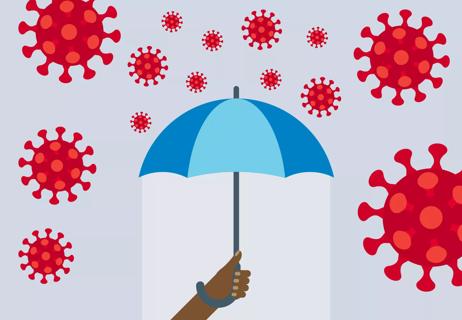The virus lives best in humans, but it can last on hard surfaces, like doorknobs and railings

No one wants to come down with a viral illness. And whether we’re talking about the common cold, RSV, the flu or COVID-19, protecting yourself from the viruses that get us sick is important.
Advertisement
Cleveland Clinic is a non-profit academic medical center. Advertising on our site helps support our mission. We do not endorse non-Cleveland Clinic products or services. Policy
So, we get our vaccines. We wash our hands. We (try to) stay away from sick people and stay home when we’re feeling ill.
And we clean and sanitize what we can — like countertops, doorknobs and other pesky places where germs can hide. Or maybe you’ve taken to protecting yourself by covering your hands with a tissue or towel when you open the bathroom door or press the buttons on the elevator. Because we’ve heard COVID-19 can live on the things we touch every day.
But what’s the timeline here? How long can COVID-19 last on surfaces?
We asked infectious disease specialist Frank Esper, MD, to weigh in.
The whole point of a virus is to invade a living host, hijack it, produce more virus babies and get out to infect more people; thus, starting the process over again. So, viruses like COVID-19 don’t survive well on their own.
When an infected person coughs or sneezes, they send out millions of viral droplets. If those droplets land on the person sitting next to them, the virus has won the jackpot. (Yay! We’ve found a shiny new home. Let’s set up camp immediately!)
But when those virus particles land on non-living things like tables, chairs, papers or counters, it’s something of a disappointment to the virus. Because surfaces don’t provide the kind of homey vibe it needs to replicate and grow.
Advertisement
“If a virus lands on something like a chair or table, it starts dying pretty quickly,” Dr. Esper states.
The virus may get lucky, though. Maybe someone will soon come along and touch the part of the surface where the virus landed. That person then touches their eyes, nose, mouth. And voila, the virus has a new home base.
But if no one comes by and picks them up in time, the virus starts to die off. Because without access to human cells to absorb the virus, the outer shell of the virus (called the capsid) starts to lose its integrity. And from there, the virus loses its illness-inducing potential.
It’s like a fish out of water. Sure, your goldfish might be OK to flop around for a few seconds while you’re transporting them into a new bowl, but you better act fast. Viruses need humans like fish need water.
So, for those COVID-19 viruses that land on a surface instead of a human … how long can they last without a new person to call home?
Research demonstrates that the virus’s survival depends, in part, on the type of surface it lands on. The live virus can survive anywhere from a couple of hours to a couple of days.
Hard, non-porous surfaces, like windows, railings, doorknobs and the like are likely to keep the virus living longer. On the other hand, COVID-19 and other viruses are less likely to last on softer materials that have teeny holes, like paper, cardboard or fabric.
“The COVID-19 virus typically doesn’t like to live on surfaces that have a lot of holes or microscopic little grooves, nooks or crannies,” Dr. Esper explains. “It likes surfaces that are very smooth, like doorknobs.”
What’s more, how long COVID-19 and other viruses last on surfaces can change depending on factors like the cleanliness of the surface, temperature, humidity and sunlight. Viruses tend to live longer in warm, moist environments and die off quicker when it’s cool and dry.
Here’s how long the virus typically lasts on some common surfaces:
It’s important to know, though that there’s a difference between a virus “lasting” on a surface and a virus “lasting-to-the-point-that-they-can-make-you-sick.”
“We may be able to find some viable virus after a few days, but it’s thousands of times less than what was originally deposited,” Dr. Esper points out. “As soon as the virus hits something that’s not alive and certainly not a human, it’s not going to do very well.”
So, just because the virus is detectable on a surface doesn’t necessarily mean that there’s enough there to infect you. Remember that viruses start to die when they’re not in the body, so the amount of live virus decreases over time on surfaces.
Advertisement
Even if COVID-19 may be seen under a microscope on something like glass for five days, the risk of getting infected from touching that glass after a few days (or even a few hours) would be lower.
The short shelf-life of COVID-19 on surfaces doesn’t mean you’re entirely in the clear.
Think about those buttons on the elevator. Maybe you don’t have to worry about catching germs from the person who rode in it three days ago. But you don’t know who was on that elevator just before you or where they may have sneezed. Their germs can still infect you.
And if you live with other people, you know you share a lot of surfaces in your home with them. If one person coughs in the bathroom and then opens the door, you know it won’t be long before you need to touch that same doorknob and could potentially catch their germs.
So, yes, cleaning, sanitizing and taking care not to needlessly touch public surfaces is still important to staying healthy. So is keeping up with your COVID-19 vaccines, washing your hands properly and following other steps to stop virus transmission.
Advertisement
Learn more about our editorial process.
Advertisement

The short answer: It’s complicated, but the basic care precautions still prevail, like washing your hands and isolating if you’re sick

They can feel like a typical headache or a migraine headache, but the pain can last for weeks to months

Any large social gathering — from a family birthday party to an indoor music concert — has the potential to spread serious infection

It’s important to connect with a healthcare provider, get quality sleep and balance your activities with your energy levels

Just like the flu, COVID-19 will continue to evolve every year

The duration varies, but symptoms can linger for a few days up to a couple weeks or more

Vaccination is best for prevention, but if you get sick with COVID-19, treatments are available

Like the flu and RSV, COVID-19 cases are rising seasonally

Type 2 diabetes isn’t inevitable with these dietary changes

Applying a hot or cold compress can help with pain